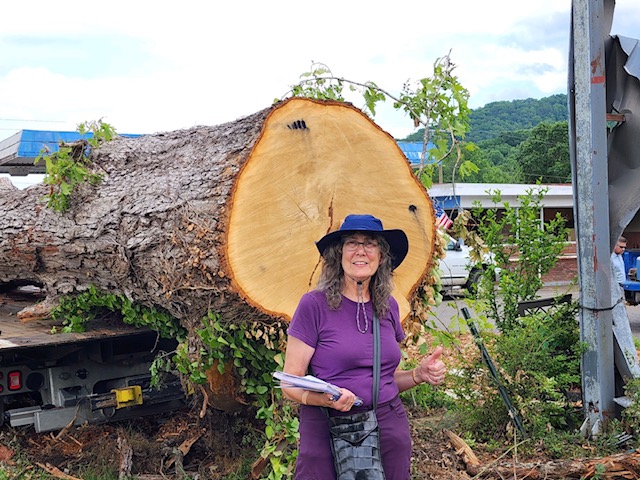Nobody in Black Mountain knows exactly how old “Robo Oil Tree” was. Experts believe the white oak emerged some time in the 18th century just feet from what would become the first roads that brought colonial settlers into the Swannanoa Valley.
What’s certain is the tree was beloved by generations of town residents, who were shocked to discover a tornado had knocked it down during the early morning hours of May 9. And while the tree is gone, its legacy will be preserved, thanks to the efforts of a small group of local residents.
“It had seen the development of the valley, the settlement of the valley, and that’s why people were really into it,” says LeAnne Johnson, executive director of the Swannanoa Valley Museum and History Center. “Plus, a lot of people have fond childhood memories of it because it was right across from the Black Mountain Elementary School. But mostly it’s because it had just been here for a very, very long time.”
The tree — which earned its nickname because it stood next to the Robo Oil Co. gas station on State Street — was among the first trees designated a Treasured Tree of the Valley by the Swannanoa Valley Tree Alliance in 2019. It was the oldest tree identified by the group.
As a member of the alliance, Faith Butterfield had grown to love the white oak. When she heard the news that it had been knocked down, she was determined to make sure the remains of the tree didn’t end up in a sawmill.
“There was just a lot of sadness, but then there was a lot of concern,” she says. “We all wondered, ‘What is going to happen to this tree? What can we do to save the legacy?'”
Teaming up
After N.C. Department of Transportation crews removed the tree’s branches, which were blocking U.S. 70, only the trunk remained. Butterfield tracked down the owner of the property on which the tree stood and was told whoever removed the trunk could keep it.
“I thought about who could possibly move this trunk, which was 18 feet long and 18,000 pounds,” she says. She reached out to fellow tree enthusiast Jeff Hall, owner of Hall’s Towing & Recovery. Hall immediately pledged to use his flatbed to move the trunk without having to cut it up.
But move it where?
Butterfield called Black Mountain Town Manager Josh Harrold, who told her the trunk could be stored in the parking lot of the town’s Public Works & Sanitation Services building until a plan could be developed for what to do with it.
Harrold met Butterfield and Hall at the site of the tree, where Hall and an employee were able to load the trunk onto the flatbed truck. With a police escort, the truck proceeded to the Public Works & Sanitation Services building.
“Luckily, I was able to get involved, and we had a space where we could put it,” Harrold says. “The tow truck driver got involved, and we made it happen. It was great teamwork, and it happened organically. There really wasn’t a plan, so we just threw things together quickly.”
The trunk will remain in the parking lot at least until it is seasoned, which could take two years. Timber seasoning is the process of reducing moisture content in wood to make it more stable and to prevent splitting or fungal/insect damage.
A committee likely will be formed to determine the fate of the wood. Butterfield would like to use it to make a large bench to be placed in front of the Swannanoa Valley Museum and History Center on State Street, less than a half-mile from where the white oak stood. There’s enough wood to make smaller benches to be placed throughout the town, she says.
But a lot of ideas are floating around, says the museum’s Johnson.
“Are we going to do a totem pole? Are we going to do a bench?” she says. “Once a committee decides what’s going to happen with the tree, we will display it that way at the museum to represent that tree and the history that it’s seen.”
Placing the chronology
Coincidentally, Harrold already had been working to preserve the tree’s legacy before Butterfield reached out.
At a meeting of the Black Mountain Swannanoa Chamber of Commerce, the town manager had run into William Forstchen, a professor of history and writing at Montreat College. Like Butterfield, Forstchen didn’t want to see all the remains of the tree destroyed.
Harrold and Fortstchen drove to the site and got permission from the property owner to saw off two cross sections from the base of the tree. Those sections are now seasoning in the parking lot along with the trunk.
The sections, known as cookies, display the tree’s rings, which appeared each year it was alive. Studying a cookie will allow a dendrochronologist to determine exactly how old the Robo Oil Tree was.
Forstchen’s plan is to mark significant events in history, such as the signing of the U.S. Constitution and World War II, on a cookie, which then would be turned into a plaque to be displayed somewhere in Black Mountain, possibly Town Square.
“We just think that it would be a neat idea for folks to see that this tree has been here for at least 200 years, if not longer,” Harrold says. “And Town Square’s a popular place. I think it would get a lot of exposure there.”
But he explains no decisions have been made yet.
“A lot of this stuff just still has to be decided,” he says. “We haven’t made it that far. I think the biggest thing was getting the tree, which we did, and we can take our time if we need to because it’s ours.”




good thinking. great project.